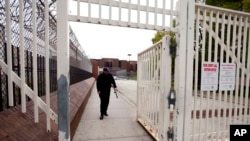Over the years, U.S. Immigration and Customs Enforcement (ICE) has issued immigration holds, also known as detainers, on individuals the agency has been seeking to deport.
But despite the latest guidance on immigration enforcement, the practice has sheriffs’ departments skeptical about the legality of these requests.
Between Friday and Wednesday, Maricopa County, Arizona, released 33 undocumented immigrants from custody even though all had ICE detainers.
Although ICE was informed about the individuals in custody, federal agents did not arrest them once these immigrants were released from the county jail.
“Last week, the Maricopa County Sheriff’s Office [MCSO] announced his office would no longer honor immigration detainers. In conjunction with the sudden reversal of a long-standing practice of honoring immigration detainers, the sheriff also implemented a restriction prohibiting the arrest of individuals with detainers by ICE officers within the confines of the facility,” an ICE official told VOA.
Maricopa authorities confirmed the county sheriff’s office was no longer honoring immigration detainers because of the threat of litigation and the need for clarification on the legality of immigration holds.
Fourth Amendment issue
Sheriff’s office spokesman Mark Casey said late Friday the Maricopa County attorney told county officials to immediately put a stop to the practice of holding a suspected undocumented immigrant for up to 48 hours after a criminal judge had ordered their release.
“We received legal advice late Friday that other jails around the country that were doing the same thing had been sued, and they were losing those suits on the basis of the Fourth Amendment,” Casey said.
The Arizona Republic reported that the 33 people were not arrested on high-level crimes, rather on charges that included criminal damage, drug possessions and driving under the influence. Some were released on bail, others on their own recognizance.
An ICE official confirmed these charges to VOA, adding some were charged with reckless driving and resisting an officer.
The federal agency also said that while the Maricopa County Sheriff’s Office did let ICE know they were releasing their inmates, they would not allow ICE to arrest them inside the jail, forcing officers to monitor the parking lots for these individuals.
Yasmeen Pitts O’Keefe, ICE spokesman, said the federal agency is working to locate and arrest those released. As of Wednesday, five of the 33 individuals suspected of being in the country illegally had been detained.
“ICE will continue to seek to collaborate with all law enforcement agencies throughout the State of Arizona, including the Maricopa County Sheriff’s Office, to help ensure that individuals who may pose a threat to our communities are not released onto the street to potentially reoffend and harm individuals living within our communities,” O’Keefe said in a statement.
48-hour hold
The American Civil Liberties Union says ICE uses detainers as a way to hold people for 48 hours without due process and, in many cases, without any charges pending or probable cause of any violation.
The practice has raised constitutional concerns and has local enforcement worried.
“We need some sort of process that will allow us to do this lawfully, and we’re prepared to negotiate that process, working with ICE and with our attorneys to figure out what works for everybody,” Casey said.
Federal courts have recently reviewed the legality of immigration detainers. According to findings, holding someone on a detainer after they have completed their local or state custody is essentially a new arrest that must meet Fourth Amendment requirements.
The Immigrant Legal Resource Center (ILRC) reports that an “immigration detainer is not a warrant, and the initiation of investigation indicated on some detainers does not provide a legal basis for detention. Even a few minutes of detention may be a Fourth Amendment violation if there is no sufficient justification for detaining the person or prolonging the stop,” according to ILRC.
The Northern District of Illinois has ruled that detainers issued out of the Chicago Field Office exceed “ICE’s own statutory arrest authority.”
Although findings from the Illinois court mentions the Chicago office, legal experts take its analysis national, “so any jail holding people on ICE detainers is risking liability for that detention.”
Next steps and legal answers
While sheriffs wait for more legal answers, in Maricopa County, Casey said they will continue to assist ICE in accordance with the law.
One way to do that, he said, is to call immigration officials and let them know when suspected undocumented immigrants “will be walking out of jail.”
“It takes five to eight hours to go through the release process. So when we get an advisory from a court that says ‘free this person’ the clock starts ticking. … We call ICE and say, ‘Hey this person that you have a hold on is walking out of here in five to eight hours,’” Casey said.
ICE officials can then stand outside the county jail and take them into custody on their immigration concerns.
The next step in the process, Casey said, is a meeting county officials requested with ICE.
“We’ve asked ICE to meet with us … so that we can begin the process to figure it out how to do this lawfully,” he said.











